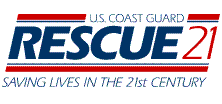 Coast Guard crews are crediting the quick reaction of rescuers and a new communications system with the survival of four boaters whose pleasure craft sunk suddenly off the coast of Catalina Island early Tuesday.
Coast Guard crews are crediting the quick reaction of rescuers and a new communications system with the survival of four boaters whose pleasure craft sunk suddenly off the coast of Catalina Island early Tuesday.
The incident began when a faint distress call drifted over the airwaves sometime before midnight Dec. 5, alerting Coast Guard crews on Terminal Island of a potential disaster.
But the precise location of the boaters was not immediately available, only a general plan of direction the group had provided family and friends before leaving Avalon Harbor, adjacent to the resort island’s main city.
But with the assistance of a new high-tech Coast Guard communications system known as “Rescue 21,” crews were able to pinpoint the men, who were found floating – their 26-foot boat sunk – in chilly waters some 13 miles off Catalina’s coast.
All were wearing life jackets and cold-water suits, and one had a radio beacon strapped to his suit, all of which rescuers say likely saved their lives, according to Coast Guard Petty Officer Trent Kelly.
That beacon, along with a float plan provided to the wife of the doomed vessel’s captain, gave a Coast Guard helicopter and the Cutter Blackfin a pinpoint origin of the radio transmission, and the men.
Once plucked from the water, “the men were evaluated by medical technicians and found to be suffering from only minor hypothermia,” Kelly said, adding that they were released later Tuesday.
Rescue 21 is a new system being implemented at Coast Guard stations covering nearly 40,000 miles of U.S. territorial coastline using global-positioning technology, improved radio frequencies and a range of other advanced communication techniques.
By harnessing global positioning and cutting-edge communications technology, Rescue 21 enables the Coast Guard to perform all missions with greater agility and efficiency. The new system will close 88 known coverage gaps in coastal areas of the United States, enhancing the safety of life at sea. The system’s expanded system frequency capacity enables greater coordination with the Department of Homeland Security, as well as other federal, state and local agencies and first responders.
When completed, this vital major systems acquisition will provide an updated, leading-edge Very High Frequency – Frequency Modulated (VHF-FM) communications system, replacing the National Distress Response System installed and deployed during the 1970s. Rescue 21 will cover coastline, navigable rivers and waterways in the continental United States, Alaska, Hawaii, Guam and Puerto Rico. By replacing outdated legacy technology with a fully integrated system, Rescue 21 provides the Coast Guard with upgraded tools and technology to protect the nation’s coasts and rescue mariners at sea.
Rescue 21 will replace a wide range of aging, obsolete radio communications equipment to include:
- Consoles at Coast Guard Sectors and Stations.
- All remote transceiver sites (antenna towers), as well as the network connecting them to the facilities above.
General Dynamics C4 Systems of Scottsdale, AZ, has been hired as the production contractor to replace the Coast Guard’s outdated system in the Contiguous 48 States and Hawaii. Due to the unique logistical and operational needs in Alaska, the Coast Guard has assumed the role of system integrator for deployment to sectors in Alaska. In August 2007, the Coast Guard commissioned the Rescue 21 Project Resident Office Alaska to spearhead the efforts.
A quantum leap forward
Rescue 21 revolutionizes how the Coast Guard uses command, control, and communications for all missions within the coastal zone. The system:
- where feasible, incorporates direction-finding equipment to improve locating mariners in distress
- improves interoperability amongst federal, state, and local agencies
- enhances clarity of distress calls
- allows simultaneous channel monitoring
- upgrades the playback and recording feature of distress calls
- reduces coverage gaps for coastal communications and along navigable rivers and waterways
- supports Digital Selective Calling for registered users
- in the Contiguous 48 States, provides portable towers for restoration of communications during emergencies or natural disasters
Source: https://www.contracostatimes.com and US Coast Guard